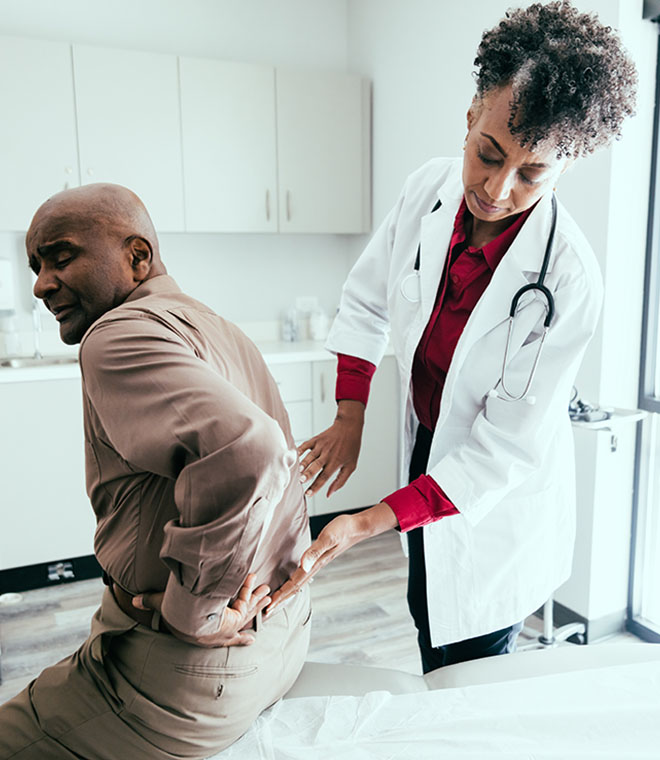Health
What are the different types of arthritis?
By Jean Cherry, MBA, RN, BSN May 22, 2022 • 8 min
Did you know there are more than 100 types of arthritis?
People can get arthritis in the joints of their hand (fingers, thumb and wrist), elbow, knee or hip. They can also get arthritis in their back, neck, shoulder, legs and feet. Though arthritis is common, it's often mistaken as a single disease rather than a general term referring to joint pain or joint disease.
Arthritis is the leading cause of disability in the U.S., affecting almost 60 million adults and 300,000 children. Most often it affects women and older adults. If you have a chronic condition, such as heart disease, diabetes or obesity, you are also more likely to have arthritis.
What are the symptoms of arthritis?
Signs of arthritis include joint pain, swelling, stiffness and decreased range of motion. Your symptoms can be mild, moderate or severe, intermittently, or get progressively worse over time. Sometimes you may have knobby-looking finger joints, but most often the damage is not visible except by X-ray. Arthritis may make it difficult to walk or complete activities of daily living due to the chronic pain and decreased range of motion. There are a few types of arthritis that affect places you would not expect, such as your heart, skin, eyes, lungs and kidneys.
What are the most common types of arthritis?
- Osteoarthritis or degenerative arthritis is the most common form of arthritis and occurs when the cartilage between bone joints wears away. When bones rub against each other, it can cause swelling, pain and stiffness.
- Inflammatory arthritis is marked by uncontrolled inflammation with joint degeneration and internal organ damage. It should be treated early to help prevent permanent damage from occurring. Examples include rheumatoid and psoriatic arthritis.
- Rheumatoid arthritis is caused by problems with the body's defense system. It affects joints and bones and can also affect internal organs and systems.
- Psoriatic arthritis affects the skin with scaly red and white patches. It also affects joints and tissues that attach to bones.
- Juvenile arthritis is a type of arthritis in children where joints become inflamed.
- Ankylosing spondylitis or spinal arthritis affects the spine or joint between the spine and the pelvic bone. Symptoms include pain, redness, swelling and heat. It can cause stiffness in your hips, feet or hands.
- Metabolic arthritis is a form of arthritis marked by severe pain. When purines (a natural substance found in the body and some foods) are broken down by the body, they form uric acid. Some people make more uric acid than others or don't get rid of it as efficiently. This causes a buildup of needle-like crystals in the joints, which cause acute joint pain or a gout attack. If it becomes a chronic condition, the pain may become disabling.
- Gouty arthritis or Gout, a type of metabolic arthritis, usually starts with searing pain in the joints of the big toe and can affect other joints where crystals build up.
- Infectious arthritis is arthritis inflammation caused by bacteria, virus or fungus. Examples include food poisoning caused by salmonella or shigella, sexually transmitted diseases, such as chlamydia and gonorrhea, and blood-to-blood infections, such as hepatitis C.
- Septic arthritis, a type of infectious arthritis, could occur after an injury where the skin is penetrated or where germs enter the joint from a recent surgery. Many acute cases of this type of arthritis are caused by staphylococcus or streptococcus bacteria.
- Reactive arthritis arises from an infection in your body that travels to joints. It causes pain and swelling in your joints, urinary tract or eyes.
- Osteoarthritis of the jaw occurs when a group of degenerative and inflammatory joint disorders affects the temporomandibular joint (TMJ). It causes pain and dysfunction of the jaw joint and muscles that control jaw movement. Approximately 10 million Americans are affected by pain in the TMJ, and it is more commonly seen in women.
- Basal joint arthritis is a form of thumb arthritis caused by wear and tear or degenerative osteoarthritis of the basal joint at the base of the thumb.
- Facet arthritis affects the facet joints where the disc space in the spine settles and collapses from the wearing away of cartilage. Besides aging, other risk factors include genetics, history of trauma, degenerative disc disease and poor posture.
- Gonococcal arthritis is inflammation of a joint caused by a gonorrhea infection. It is more common in sexually active teenage girls. Bacteria are spread through the blood to a joint or multiple joints.
- Enteropathic arthritis or EnA is a chronic, inflammatory arthritis that is associated with inflammatory bowel diseases (IBD), such as Crohn's disease or ulcerative colitis. Symptoms include pain in the limb joints of the spine, plus abdominal pain or bloody diarrhea.
- Lyme arthritis occurs due to Lyme disease when bacteria enter joint tissue and cause inflammation. This can cause pain and swelling in joints, especially the knee. If it's not treated, permanent damage to the joint can occur.
- Arthritis affecting the eyes can be caused by several conditions. These can include:
- Dry eye syndrome: when the cornea lens starts to dry out
- Scleritis inflammation: when redness in the white part of the eye doesn't go away
- Inflammation of the uveitis or vascular part of the eye
- Retinal vascular occlusion: when the small blood vessels in the eye feeding the retina become blocked
- Glaucoma: when the valve for the pump in the eye becomes inflamed
- Cataracts: when the lens becomes cloudy due to inflammation of the eyeball
- Pyrogenic arthritis or pyogenic arthritis-pyoderma gangrenosum-acne (PAPA) syndrome is a genetic condition that occurs in children. It is a rare autoinflammatory disorder that can affect the joints and skin.
How can symptoms be minimized?
Home remedies that may help to reduce general symptoms of arthritis include exercise, applying hot and cold therapy, relaxation therapies, splints and braces, and assistive devices.
If you have painful joints, contact your healthcare provider to see if it could be arthritis. They can diagnose your condition and recommend the best treatment plan for the type of arthritis you might have.
Clinically reviewed and updated by Nora Laberee, May 2022.
Sources:
- https://orthoinfo.aaos.org/en/diseases--conditions/cervical-spondylosis-arthritis-of-the-neck/
- https://www.arthritis.org/about-arthritis/understanding-arthritis/what-is-arthritis.php
- https://www.arthritis.org/living-with-arthritis/comorbidities/eye-conditions/eye-arthritis.php
- https://medlineplus.gov/ency/article/000430.htm
- https://www.niams.nih.gov/health-topics/arthritis
- https://rarediseases.info.nih.gov/diseases/9176/pyogenic-arthritis-pyoderma-gangrenosum-and-acne
- https://www.nidcr.nih.gov/health-info/tmj/more-info
- https://www.spondylitis.org/Enteropathic-Arthritis
- https://www.mayoclinic.org/diseases-conditions/thumb-arthritis/symptoms-causes/syc-20378339
- https://sportsmedicine.mayoclinic.org/condition/facet-arthritis
- https://medlineplus.gov/ency/article/000453.htm
- https://www.cdc.gov/lyme/treatment/LymeArthritis.html



